EGYPTOLOGY: The Temple of Deir El-Hagar
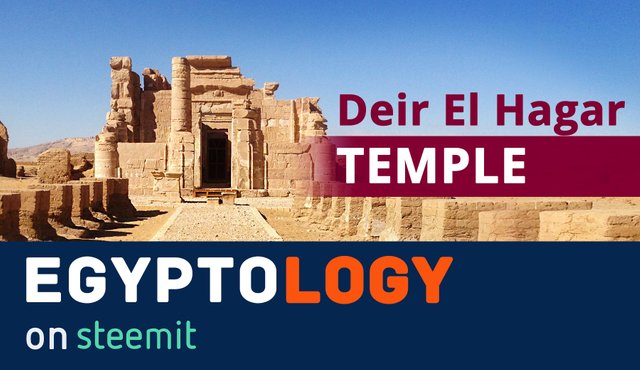
I promised you in my last post when I gave you a short introduction to the Dakhla Oasis in the western desert of Egypt, that the next one will be about Deir El-Hagar Temple. And here it is: a pearl in the shadow of the famous monuments along the Nile. It is located in the north-west of Dakhla and not far away from the modern civilisation.
Ruins in the Sand
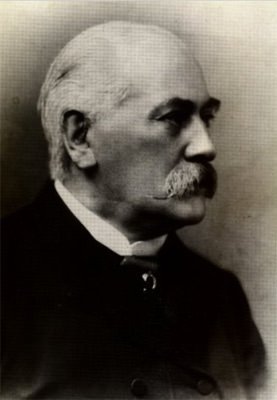
When the Rohlfs Expedition, a team of explorers under the direction of Gerhard Rohlfs, took their route through the Libyan desert around 1834 they stumbled upon these big fragments of (partially) decorated stones that stuck in the ground, and they began to excavate with the aim to photograph the pieces. On the picture below you can see in which condition the remains of this great monument were found.
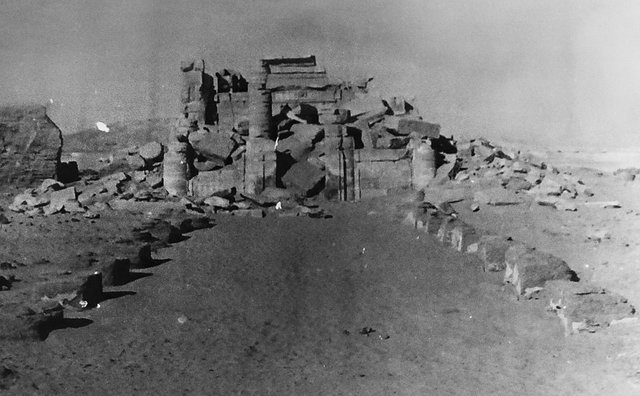
Later in the 19th century, between the 60s and the 70s, the Egyptian Archaeologist Ahmed Fakhry started to excavate the area on a professional level. Most of the artefacts, such as statues and other smaller items are now stored and on display in the Kharga Museum, that I will visit within the next days (and of course from which you will get an exclusive report from).
Restauration and Conservation in the 20th Century
Under the direction of the Dakhla Oasis Project (DOP), an international mission funded by the Dakhleh Trust, a charity organisation from the UK, and with the help of the Supreme Council of Antiquities in Egypt the Temple of Deir El-Hagar was restored and rebuilt (1992–1995). The fragments were put together in the best possible way, although the correct position of a few blocks remains unclear and so they were put behind the temple for further research.
The Name and the Architecture
Deir El-Hagar is Arabic (دير الحجر) and means simply „Monastery of Stones“. It was built probably in the first half of the first century A.D. and then went through several stages of extension. There were found 4 inscriptions of Roman emperors that probably used this temple for worshipping Ancient Egyptian Gods and Goddesses (see paragraph below). They were Nero, Vespasian, Titus and Domitian (see their name cartouches below).
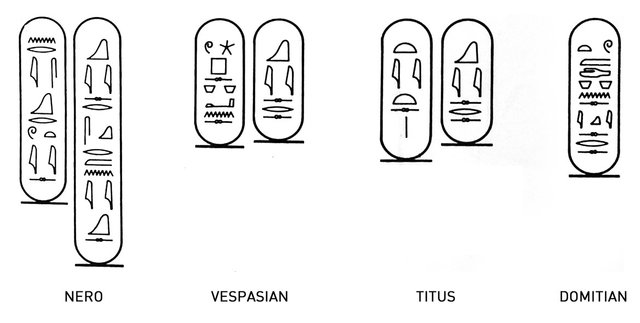
Here are now the first impressions from the Deir El-Hagar Temple taken on January 1st 2018:
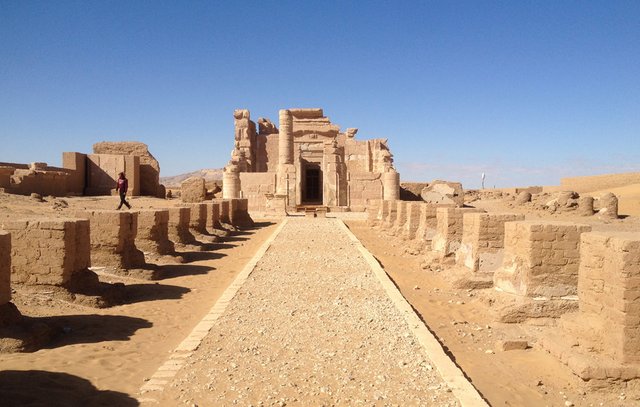
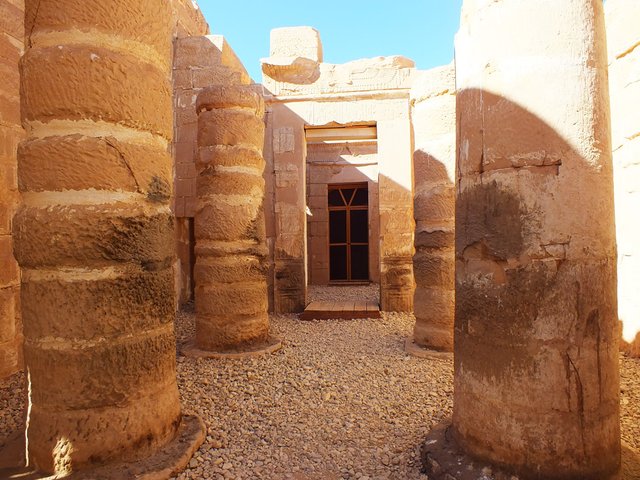
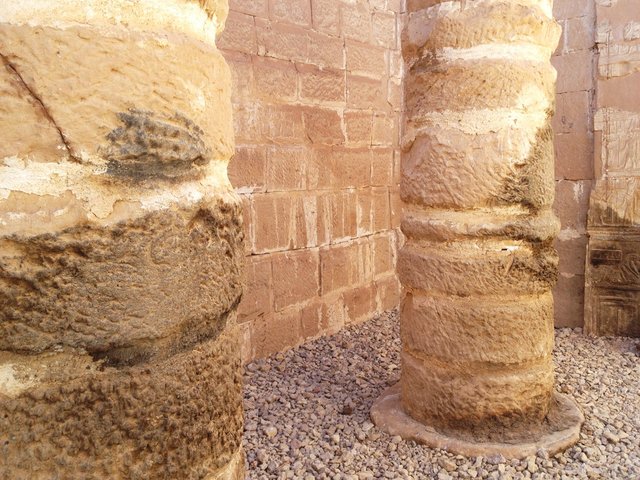
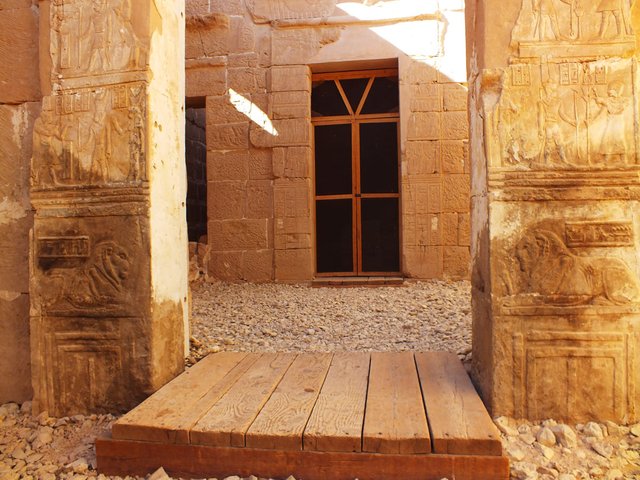
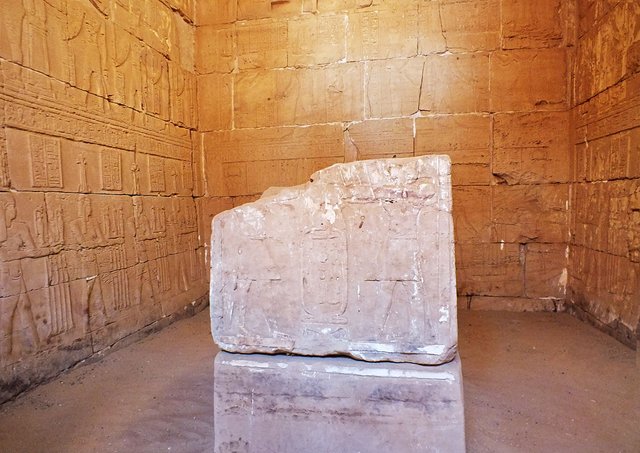
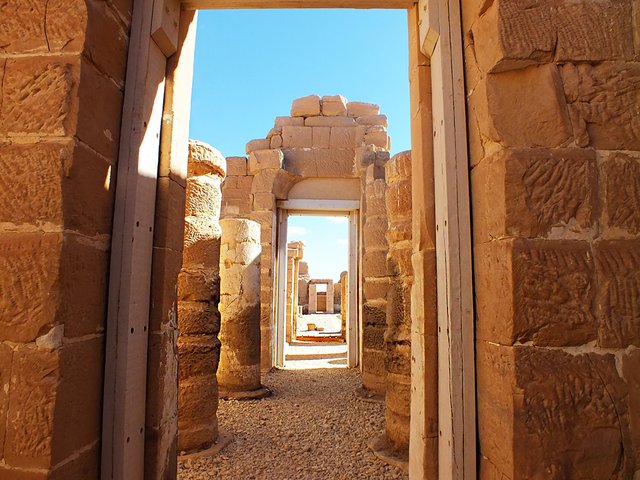
The Astronomical Ceiling
There is a very unique and special item which can be found not directly in the temple but behind it: a so-called „astronomical ceiling“. Normally this kind of ceilings is part of the Pronaos, a more illuminated area within the temple. But in Deir El-Hagar the astronomical ceiling was located in the sanctuary, the holiest, but also darkest spot.
Due to the fact that the blocks are too heavy and the remains of the ceiling very fragmented, the restorer chose to give them a special place from which it can be directly viewed. This is also the reason why the Goddes Nut, that Goddess that carries the heaven on her back, which is usually depicted with a bowed spine, can here be seen bowing in the opposite direction as normal. This can be confusing, but if you keep in mind that this picture was once on the ceiling, it makes sense again.
The Belgian Egyptologist Olaf Kaper, who did an intensive work in that temple, dedicated a part of his research to this special artefact (see remarks for further reading below).
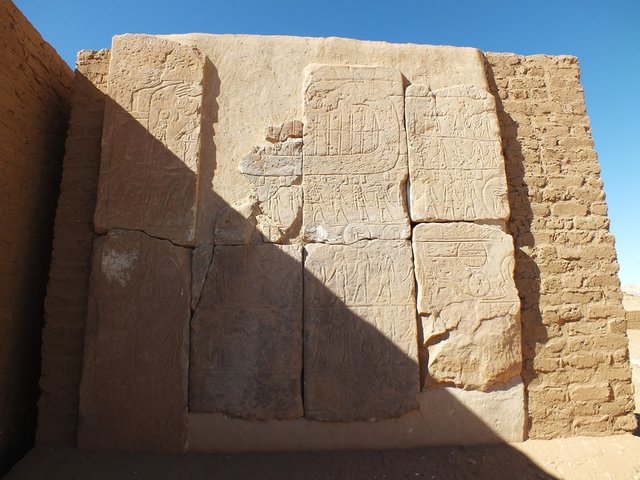
The „Theban Triad“ and other Deities
Most of the worshipped Gods depicted in the Temple of Deir El-Hagar belong to the so-called Theban Triad which consists of Amun-Re, Mut and Chons (see graphic below). They are getting offerings from the king.
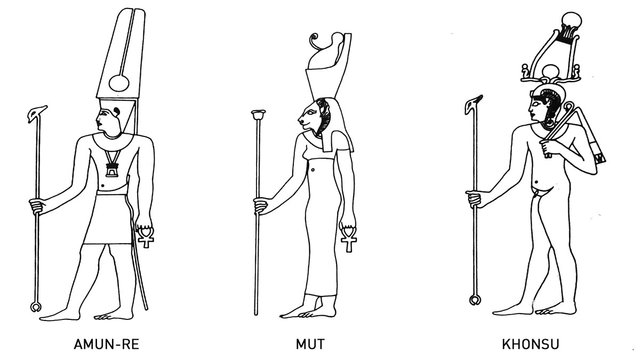
Beside this other well-known deities appear, like Hathor, Isis, Nephthys and Thot.
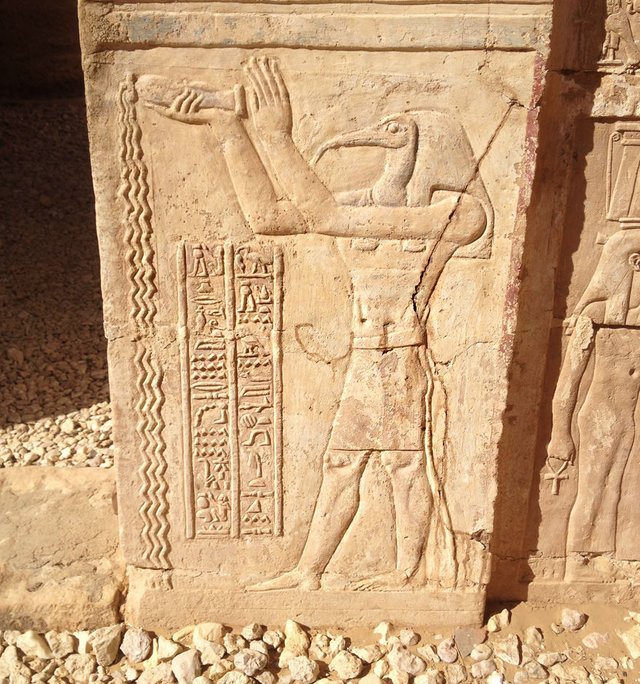
Alternatively, this can be seen as a so-called „libation“, but since the location of this image is right at one of the entrances to the Naos, it is more likely that it has a „cleansing“ function. You must imagine that not many people had access to the temple in general, but those who had were mostly priests of a high rank (and of course the king himself). This temple staff were people that dedicated their life to the temple and wore special clothes and haircut (often no hair at all). This purification aspect is key to be able to perform rituals. So it is not surprising that the God Thot poured water here to enhance the effect.
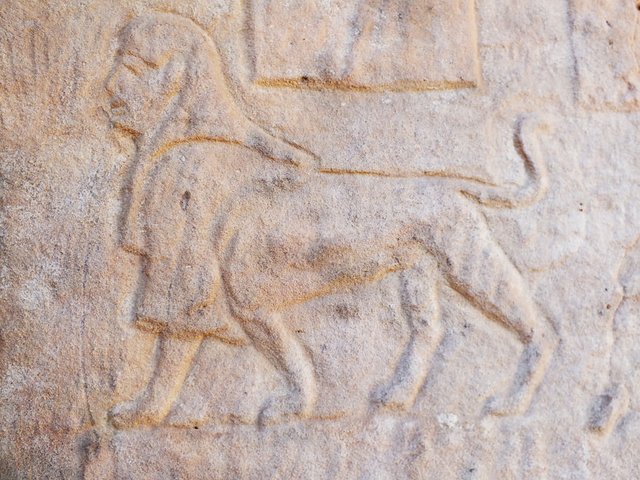
Tutu, the sphinx-like God is a deity that is unique for the Dakhla Oasis. It has a human head, a lion body with a tail that seems to be a snake (cobra), and wings. Such hybrid creatures are in general not rare as we all know the Great Sphinx of Giza which is only one example of many. But Tutu here consists of more than two parts that don’t come out of a natural „interbreeding“.
Lions and lion-like Gods
As I mentioned in my articles before, my aim here is to do some research on the depicting of lions and lion-like entities especially in the oases of Egypt. I choose this special topic because, most of the iconographic studies focus on the northern influence such as from the Greco-Romans or from Near Eastern (Mesopotamia and Levante) and I feel there is a lack of consideration about the potential importance of the south – Nubia and Sudan. This „missing link“ between those cultural inflows on the north-south axis I try to fill with my research here because the oases of Egypt are somewhere „in between“. Of course, they received a lot of attention during the Greco-Roman period and the Deir El-Hagar Temple is the best example for this since Roman emperors left their footmark there. But the lion itself is an animal that usually cannot be found in the desert at all. Even more – its natural habitat has extended to the south and along the Nile in ancient times, and the Temple of Muzawarat as Sufra in the Kingdom of Meroe (Sudan) is an impressive indication of the thesis that the actual origin of the „lion cult“ in Ancient Egypt could be located in the south instead of the north.
But so far, I am still collecting material, and I wanna show you here two examples:
In the Deir El-Hagar Temple appear at least two lions – one to the left and one to the right side of the entrance tot he Naos before you go into the sanctuary. Here you can see again remains of oil or blood that was probably poured to the entrance during the worshipping ceremony. It is likely that these two lions had the function of „gate keepers“, although their posture is more of a relaxed animal than of an aggressive one. It seems they had to be made peaceful for the members of the ritual to get access to the sanctuary.
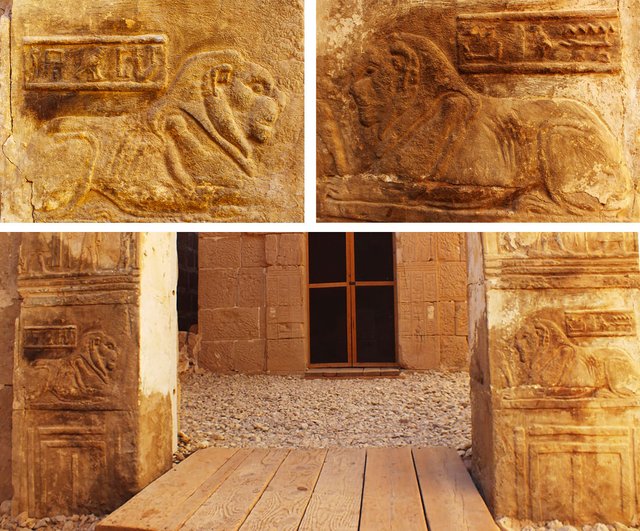
As mentioned above Mut, as part of the Theban Triad is also depicted on the temple walls. This lion-headed Goddess appears quite often on the decorated walls of the temple. Her function in the Ancient Egyptian Pantheon (= the sum of all deities) was similar to that of Hathor or Isis – she was the symbolic mother of the Pharao/the King whom she protected. In hieroglyphs her name was written with the vulture: 𓅐𓏏.
Her husband is Amun (as in Deir El-Hagar Amun-Re), and her main cult place was the Karnak Temple in Thebes (today Luxor). She shows up with a human head, a cat head or – like here in Deir El-Hagar with a lion head.
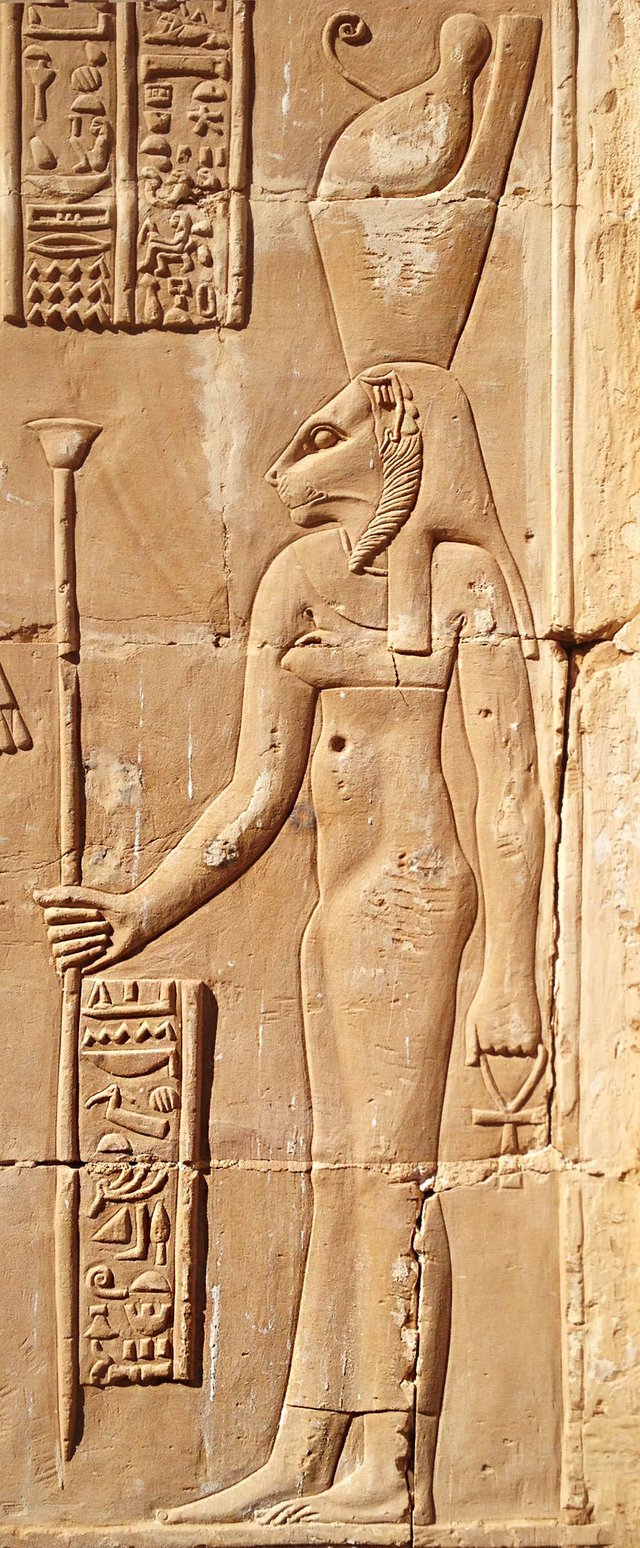
Summary
The Temple of Deir El-Hagar, the stone monastery, is indeed a secret treasure of the Ancient Egyptian history since it differs in many aspects from decoration concepts of other temples. Also, unique deities have their home here. It is a blessing that this monument could be restored so well and the work is still going on. As far as I know, the Dakhla Oasis Project is still active and especially epigraphic work will be done in the future. Therefore pictures are taken and drawings are made from the inscriptions in a very detailed way for further philological research.
Sources:
• Hope, Michael, Colin A. [eds.] ; Birrell, Hrsg. Dakhleh Oasis Project : preliminary reports on the 1992 - 1993 and 1993 - 1994 field seasons. Dakhleh Oasis project ; 8, 1999.
• Hope, Roger S., Colin A. [eds.] ; Bagnall, Hrsg. Dakhleh Oasis Project : preliminary reports on the 1994 - 1995 to 1998 - 1999 field seasons. Dakhleh Oasis project ; 11, 2002.
• Kaper, Olaf E. „Doorway decoration patterns in the Dakhleh oasis.“ In: 3. Ägyptologische Tempeltagung, Hamburg, 1.-5. Juni 1994: Systeme und Programme der ägyptischen Tempeldekoration, edited by Dieter Kurth, 99–114. Wiesbaden: 1995.
• Kaper, Olaf E., „Egyptian toponyms of Dakhla Oasis.“ Bulletin de l’Institut Français d’Archéologie Orientale 92 (1992): 117–32.
• Kaper, Olaf E., „‚Nieuwe‘ tempels in de Oase Dachla.“ Phoenix 39, Nr. 1 (1993): 11–25.
• Kaper, Olaf E., „Temple building in the Egyptian deserts during the Roman Period.“ In Life on the fringe: living in the southern Egyptian deserts during the Roman and early-Byzantine periods. Proceedings of a colloquium held on the occasion of the 25th anniversary of the Netherlands Institute for Archaeology and Arabic Studies in Cairo, 9 - 12 December 1996, edited by Olaf E. Kaper, 139–58. Leiden: 1998.
• Kaper, Olaf E., Temples and gods in Roman Dakhleh: studies in the indigenious cults of an Egyptian oasis,1997.
• Kaper, Olaf E., „The astronomical ceiling of Deir el-Haggar in the Dakhleh oasis.“ Journal of Egyptian Archaeology 81 (1995): 175–95.
Mills, A. J. „The Dakhleh Oasis Project: report on the 1991-1992 field season.“ Journal of the Society for the Study of Egyptian Antiquities 20 (1990): 17–23.
• Shaw, Roberta L. „Projets connexes sur l’Oasis: le temple de Deir el-Haggar / Oasis Projects: the temple of Deir el-Haggar.“ In: Canadians on the Nile / Rives égyptiennes: le Musée royal de l’Ontario et la découverte de l’Égypte ancienne / the Royal Ontario Museum and the discovery of ancient Egypt, 52–57. Paris: 1999.
• Winlock, H.E. Ed Dakhleh Oasis. Journal of a Camel Trip Made in 1908. With an Appendix by Ludlow Bull. - New York 1936. XII, 77 S., XXXVII S. Abb. 4°. [Metropolitan Museum of Art. Publications of the Department of Egyptian Art. vol. 5.], 1936.
• Dakhla Oasis Project
Images:
• Pict. 1: Source
• Pict. 2–3: Photograph of a poster in the visitor center of Deir El-Hagar. (own photo, digitally enhanced)
• Pict. 4–10: Own photographs.
• Pict. 11: Photograph of a poster in the visitor center of Deir El-Hagar. (own photo, digitally enhanced)
• Pict. 12–17: Own photographs.
Feel free to ask all the question of what you always wanted to know about Ancient Egypt. That’s my job and my passion. Let’s discuss your thoughts and ideas.

If you liked this article, please follow me on my blog @laylahsophia. I am a german Egyptologist writing about ancient and contemporary Egypt, history of science, philosophy and life.
thank's a lot, this is good european refences for my student.
Thank you too. :)
Wow, girl, this is amazing! If I could, I'd upvote it 100 times. :)
Thank you, @dreamdiary. :)
How is the temple protected from sandstorms today? Have they built walls around it?
The original wall, a so called "temenos wall" is still there, although it has some gaps. But the restorers built an additional fence around made of local reed plants. This is very effective against sandstorms, but of course it will have to be renewed from time to time.
Here is an example of the wall and the fence behind it. :)
Wow! It looks huge!
This post has received a 0.63 % upvote from @drotto thanks to: @steemstem-bot.
Well done! This post has received a 16.67 % upvote from @litasio thanks to: @steemstem-bot. Whoop!
If you would like to delegate to the @LitasIO you can do so by clicking on the following link: 10SP
Awesome informative post and great photos!
https://steemit.com/indonesia/@ridhomaslizal/5-mistakes-wear-charger-that-makes-smartphone-batteries-fast-wasteable
Thanks for this. Good to read your posts. Very informative. And great to see something a bit off the beaten track. I never managed to get into the Libyan Desert area as we were forbidden to go there. Also noticed your photos were just this year so well done for visiting.
Wow, this is incredibly interesting. I became somewhat interested in Egyptian mythology after they used it as the basis for some of the storylines in the television series Stargate SG-1. (The pyramids were platforms to land spaceships on, just to name a crazy example, haha). Brilliant article! Followed.